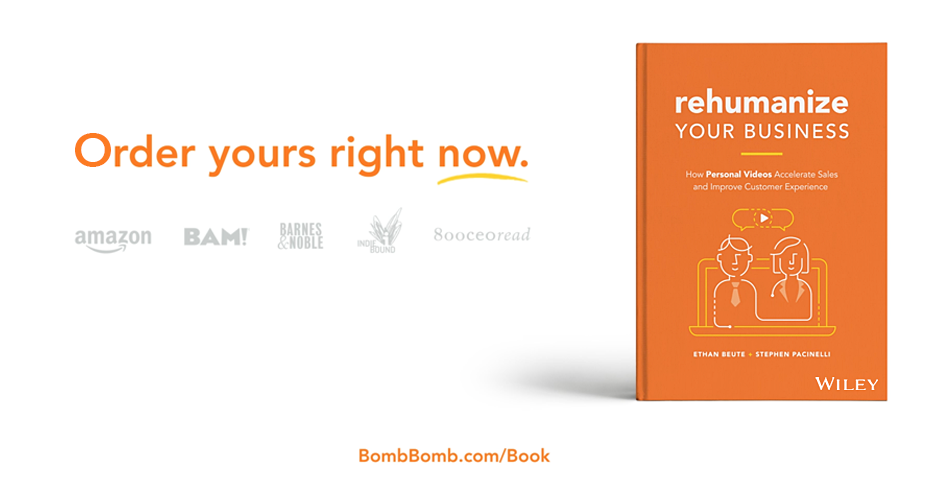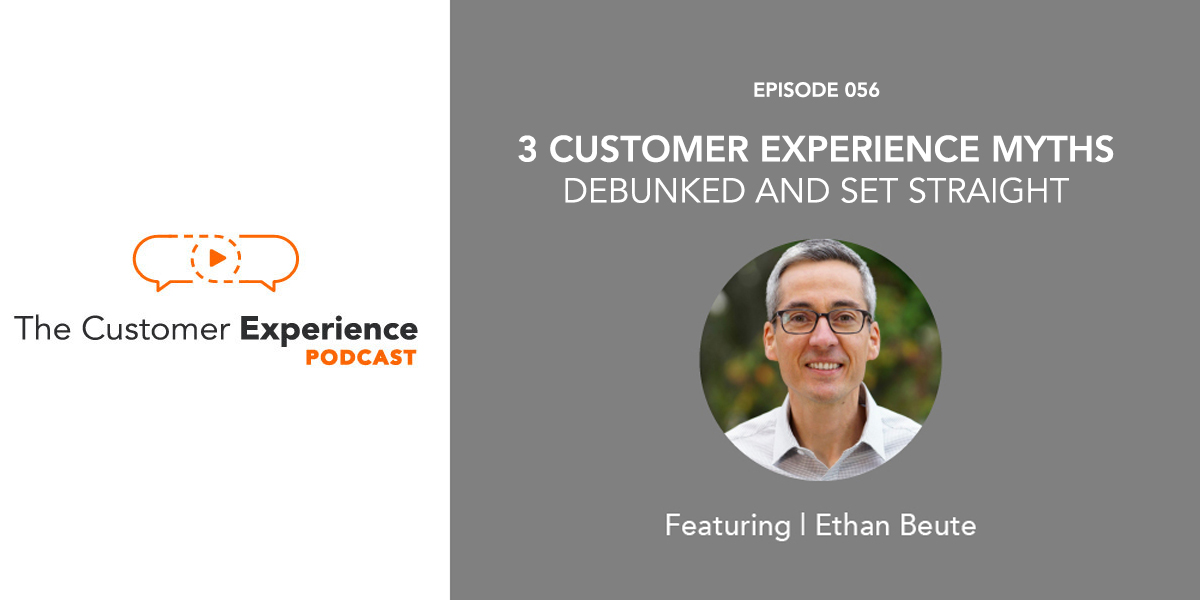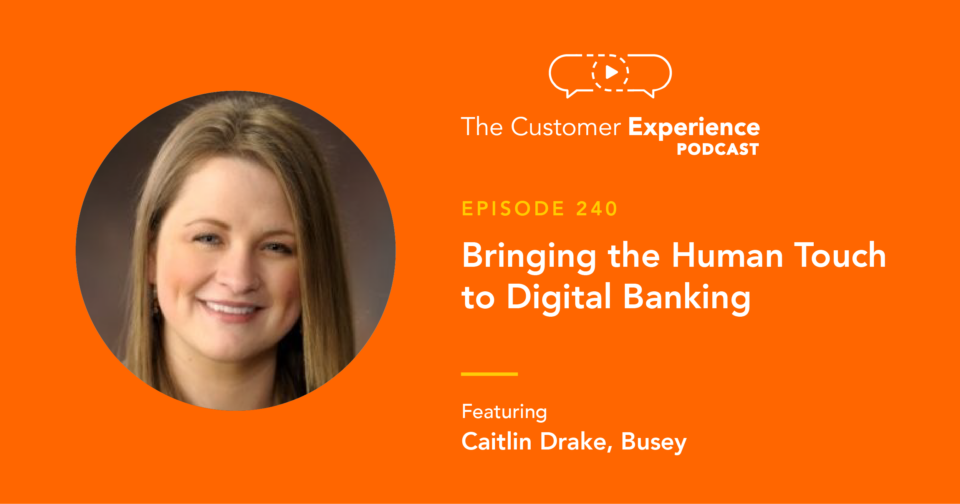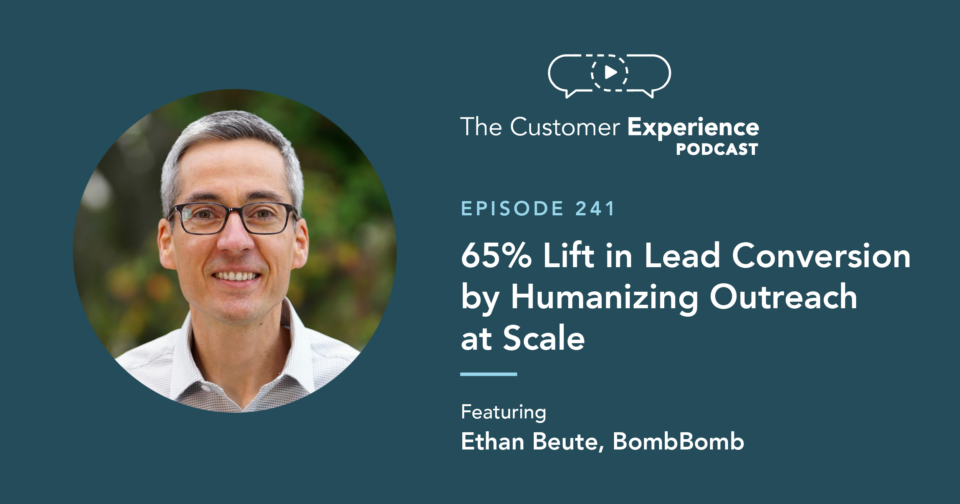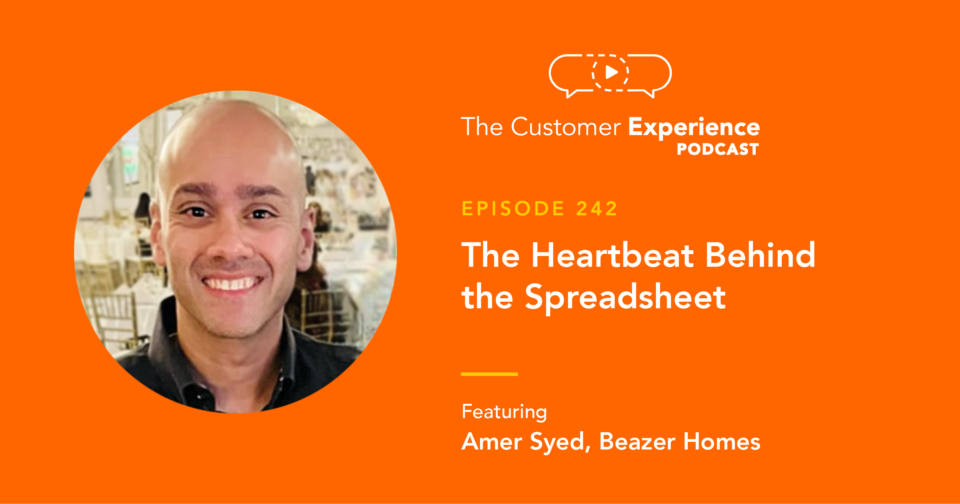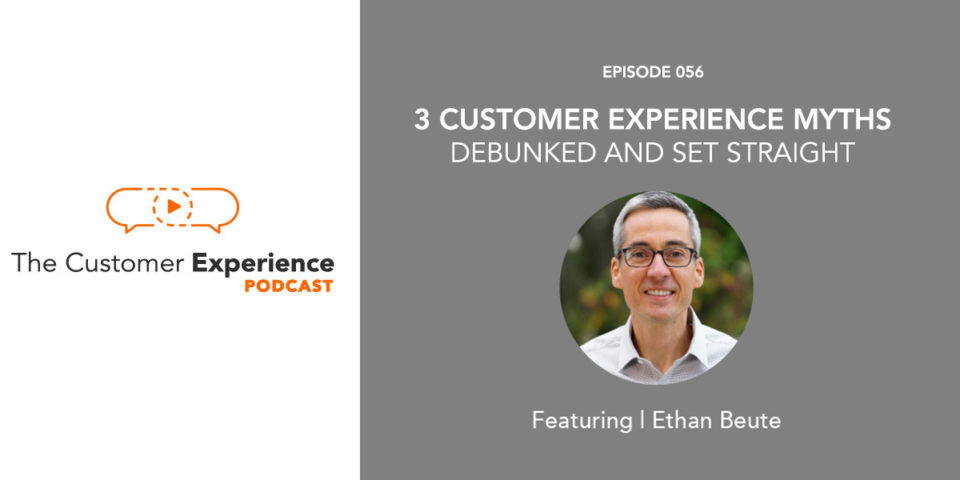
Listen to “56. 3 Customer Experience Myths Debunked & Set Straight w/ Ethan Beute” on Spreaker.
Apple Podcasts | Spotify | Stitcher | Google Podcasts
The most economically valuable thing you can do is to meet customer expectations.
Yes, meet their expectations. Not exceed customer expectations. Not surprise and delight your customers at every turn. The best way to economically and experientially serve your customers is to meet their expectations.
On this 12-minute solo episode of The Customer Experience Podcast and here in this blog post, I share my appreciation for and debunk a few customer experience myths with a book that I’m late to the party on.
The book is called The Effortless Experience: Conquering the New Battleground for Customer Loyalty (Portfolio/Penguin, 2013) by Matt Dixon, Nick Toman, and Rick DeLisi. Dixon also coauthored The Challenger Sale and The Challenger Customer.
My takeaways here from The Effortless Experience may not hold revelations for the more well-studied and expert customer success practitioners who listen to the show, but they likely will be for everyone else. The takeaways mentioned in this episode come only from the first chapter of the book, which is based on research with 97,000 consumers and hundreds of executives inside businesses serving these customers.
An early, provocative quote:
“What if you got up in front of the team and instead of asking them to delight your customers, you ask them to make things as easy as possible for your customers?
The quote continues: “And you told them to do this by focusing on a small set of actions, like avoiding situations where the customer is likely to have to call back, not transferring customers when they can handle the issue themselves, not asking customers to repeat themselves, not treating people in a generic manner, and so forth.”
Those four situations to avoid, by the way, are four of the experiences that annoy customers most. And I’m sure you can relate.
Interested? Great! Let’s get into three myths debunked by the research and writing of Dixon, Toman, and DeLisi.
3 Customer Experience Myths Debunked and Set Straight
The first chapter of The Effortless Experience starts out by calling out myths that tend to be overlooked by marketing, sales, and leadership — but which are highly relevant to these people and their organizations. There’s so much focus on customer delight and the so-called “wow moments,” but not enough focus on two things that are much simpler and more economically valuable: meeting customer expectations and reducing their effort.
Based on their research, here are three customer experience myths debunked and set straight:
- Delighting customers in the service channel does not pay.
- Customer service drives disloyalty, not loyalty.
- The key to mitigating disloyalty is reducing customer effort.
You may have had a strong or curious reaction to one or more of these, so we’ll take them one by one.
Keep listening or reading below as I walk you through what these myths are, why they’re so important, and what you can do about them to improve customer loyalty and meet expectations.
If you’d prefer to listen to this in a podcast player, find the podcast here:
Because you’re reading this blog post, I’ve also embedded this 12-minute episode right here:
Listen to “56. 3 Customer Experience Myths Debunked & Set Straight w/ Ethan Beute” on Spreaker.
1. Delighting Customers Does Not Pay
The Myth: we should work to surprise and delight our customers.
Debunked: we should work to assure that customer expectations are met.
Delight is not the fully sensible and most effective mission of the CS or CX organization. A lot of the stories that we hear are typically what they call “lottery ticket logic,” wherein we tend to over-celebrate the rare moments of delivering above and beyond an overspend on training toward moments of, wow.
As the authors wrote, “There is virtually no difference at all between the loyalty of those customers whose expectations are exceeded and those whose expectations are simply met. Loyalty actually plateaus once customer expectations are met.”
What, then, does loyalty mean in this context? The authors define it with three specific behaviors:
- Repurchasing, continuing to buy from you
- Share of wallet, buying more from you over time
- Advocacy, recommending you to others
In these terms, loyalty doesn’t mean a fanatic devotion to you, your company, and your brand. It means a customer who keeps purchasing, purchases more, and tells others about the purchases. It now bears repeating that there’s no difference in loyalty between customers whose expectations are exceeded versus those who are simply met. Economically (and logically), it’s more costly to exceed expectations, especially when you don’t have to, when you only have to meet expectations to secure loyal customers.
Per The Effortless Experience: “The data show that an aggregate customers who are moved from a level of below expectations up to meets expectations offer about the same economic value as those whose expectations were exceeded.”
Since exceeding expectations is more expensive from an operational standpoint, the customer experience goal should be basic competence, professional service, and getting the fundamentals right, meaning solving the problem and getting people back to their day.
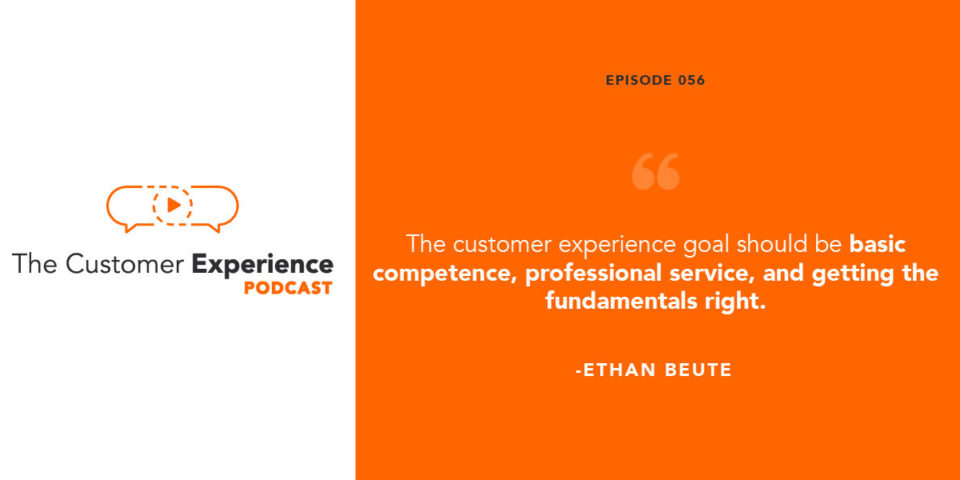
2. Customer Service Drives Disloyalty
The Myth: Customer service drives loyalty.
Debunked: Customer service interactions are 4x more likely to drive disloyalty than to drive loyalty.
Let me speak personally here for a minute. At BombBomb, we have amazing customer success and customer support people. Relationships are our #1 core value, so we do strive to go above and beyond when someone comes to us with a problem. Often, we get very positive replies about how a particular team member of ours made someone’s day or really over-delivered for a customer. We see it in NPS verbatim feedback. We see it in our CSAT scores. And our team is properly proud of that.
But in aggregate, according to the research team behind The Effortless Experience, any customer service interaction is 4x more likely to drive disloyalty than to drive loyalty. Even worse, the book said that those customers we make disloyal are much more likely to spread that disloyalty to other potential customers through negative word of mouth. Chew on these two stats straight from the book for a moment.
- 45% of the people who had something positive to say about a company told fewer than 3 people
- 48% of people who had negative things to say shared that negative speak to more than 10 people
Bottom line: Those with positive experiences share less, and those with negative experiences share more. And those who interact with customer service are 4x more likely to have a negative experience.
“We pick companies because of their products, but we often leave them because of their service failures,” wrote the book’s authors. We shouldn’t hide from our customers or cut back customer service. But we must provide a great product or service experience so people don’t need to get into our customer service channels in the first place.
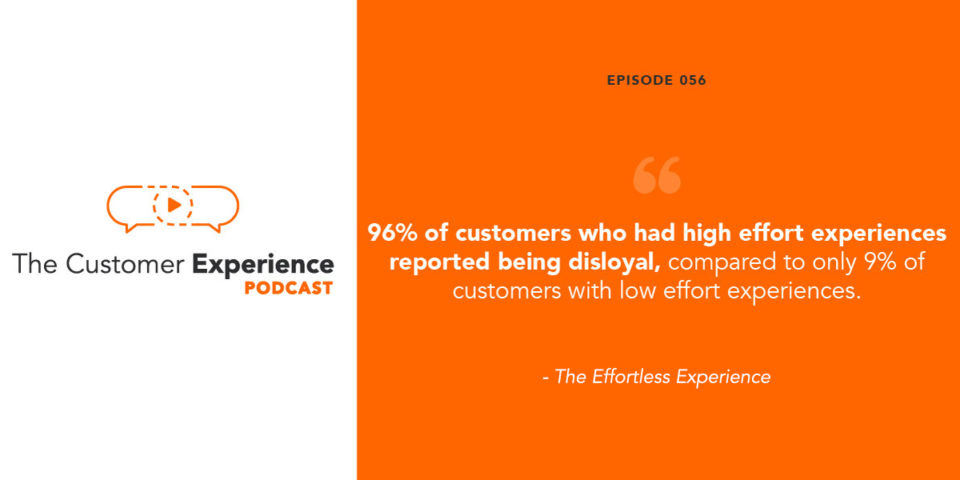
3. Mitigate Disloyalty By Reducing Customer Effort
The Myth: surprise and delight mitigate customer disloyalty.
Debunked: reducing customer effort and meeting customer expectations are the keys to loyalty.
Another top takeway from the first chapter of The Effortless Experience is that the key to mitigating disloyalty is reducing customer effort. This concept tees up the rest of the book, which is about … you guessed it: reducing customer effort.
Four of the 5 drivers of disloyalty are about additional effort that customers must put forth. Here they are again in rank order:
- Requires more than one contact to resolve the issue
- Generic service (treating people like a number, noncommittal responses, corporate speak)
- Having to repeat information
- Perceived additional effort to resolve the issue
One thing that contributes directly to perceived effort is transfers – customers getting bounced around through agents or departments. The more that CS bounces people around, the more perceived effort there is, and the greater likelihood that you’re producing disloyalty.
These 4 issues are insanely common. Of the nearly 100,000 people interviewed, 56% said they had to re-explain their issue during a service interaction. 59% had a higher perceived additional effort to resolve the issue. 59% also said they were transferred during a service interaction. 62% said it took more than one contact to resolve the issue.
All of that customer effort produces frustration therefore disloyalty. In a low-effort experience, only 9% of people were disloyal. But when we’re asking our customers to spend time and energy (mental, physical, or emotional), 96% of the people in these high-effort experiences were disloyal.
Fighting The Customer Experience Myths
So where do we go from here? For starters, I highly recommend reading The Effortless Experience. Everything I’ve shared in this post and in this podcast are from the first chapter, which offers up the following four principles to create low-effort experiences before proceeding to share with you how to do it all.
1. Minimize channel switching by boosting the stickiness of self-service channels. This prevents customers from having to reach out in the first place.
2. Head off the potential for subsequent calls by having employees practice next issue avoidance and being a little bit proactive. For example: “Hey, now that we’ve addressed what’s really on your mind right now, let me tell you about what might happen next.” Proactively avoiding future issues offers a huge value to the customer because it reduces effort.
3. Succeed on the emotional side of the service interaction. I’m recommending you turn to The Effortless Experience for experience engineering tactics and very specific things you can do to manage this. For myself, I suggest using video to manage that emotional side of the service interaction (more on that in this podcast episode).
4. Use incentive systems for service reps that value the quality of the experience over merely speed and efficiency. It’s much easier to measure and reward speed and efficiency compared to quality, but quality service and support go a long way toward effort reduction. It’s a huge value driver in your business.
The Effortless Experience: Conquering the New Battleground for Customer Loyalty goes into more detail on all of these topics, but I wanted to take the time here to share with you several impactful takeaways from the provocative first chapter.
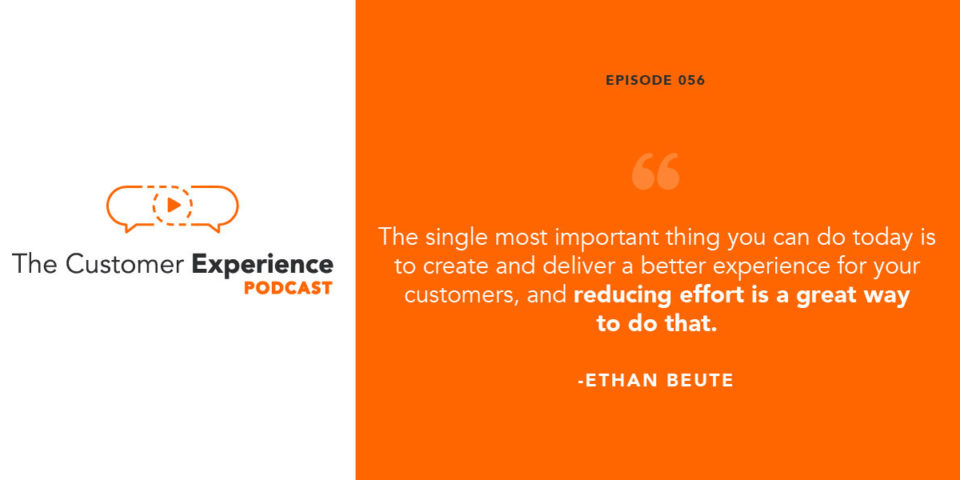
I’d love to hear your feedback on this episode on LinkedIn, by email (Ethan at BombBomb dot com), or in review and rating of The Customer Experience Podcast.
Get More Customer Experience Truths
Every week, we talk customer experience with leaders and practitioners in marketing, sales, customer success, product, branding, and more. Our goal is to create alignment throughout your organization in service of your customers.
Hear more short, solo episodes like this one right now:
- Video Belongs in These 3 Moments of Your Customer Journey
- 5 CX Tips from My Car Buying Experience
- How NOT to Use LinkedIn Messaging for Prospecting
- Rehumanize Your Business by Building Relationships Through Video
Subscribe, rate, and review the podcast here:
Get the Definitive Guide to Simple, Personal Videos
Video gives your customer support, customer service, or customer experience team a more personal and human way to communicate and connect with your customers. When people receive a video with a thank you, apology, or answer to their question, they don’t feel like a number. They feel valued and appreciated.
And it doesn’t require lights, scripts, editing, or production.
Get started by picking up the Amazon #1 bestseller in Customer Relations, Business Communication, and Business Sales, the Porchlight Book Company/800-CEO-READ #1 bestseller in its opening month of release, and a Barnes & Noble bestseller it its opening week of release.
Check out expert endorsements from bestselling author Daniel H. Pink, Principal of Marketing Insights at Salesforce Mathew Sweezey, cofounder and Chief Evangelist at Terminus Sangram Vajre, and many others. See what’s inside the book. And choose your preferred place to order one or more copies, including the recently released audiobook.
